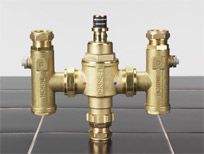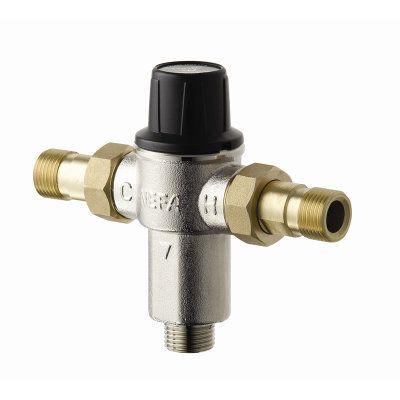TMV vs Tempering Valve - What are they and why do we need them?
Tempering valves and TMV's get mixed up quite a bit so we've put together some facts to help our customers understand what they are and why they should have one fitted in their home's plumbing system.

What is a thermostatic mixing valve (TMV)?
A thermostatic mixing valve is a device which blends hot and cold water to provide your home with a reliable consistent hot water temperature at the hot water tap. The delivery temperature is usually set by your plumber during the installation. A thermal-sensitive element within the valve expands and contracts in response to changes in the temperature of incoming hot and cold water to maintain the required delivery temperature.
NEED HELP FOR YOUR HOT WATER SYSTEM ?
Get professional help, book a great Sydney plumber here

What is a tempering valve?
A tempering valve is a 3-way mixing valve which is temperature actuated and used to temper a heated water supply by mixing the heated water with cold to feed heated water at a reduced temperature to the taps around your home.
Thermostatic mixing valves respond faster to temperature and pressure variations than tempering valves. Regular servicing is needed to ensure reliability and complete protection.
Which one to use?
The National Plumbing and Drainage Standard AS/NZS 3500.4: 2003 states - All new heated water installations shall deliver heated water not exceeding -
- (a) 45°C at the outlet of sanitary fixtures used primarily for personal hygiene purposes for the aged, sick, children, or people with disabilities in healthcare and aged care buildings, early childhood centres primary and secondary schools, and nursing homes or similar facilities for the aged, sick, children, or people with disabilities; and
- (b) 50°C at the outlet of sanitary fixtures used primarily for personal hygiene purposes for all other situations.
To comply with (a) above you must install a thermostatic mixing valve adjusted to an outlet temperature of 45°C. To comply with (b) above you must install a thermostatic mixing valve, or a tempering valve or a pre-set water heater permanently disabled at 50°C.
Why do we need to use a TMV or tempering valve?
The Plumbing Code of Australia states that stored hot water must be maintained at a temperature which prevents the growth of Legionella and other bacteria. To achieve this most hot water storage tanks are set to 60°C+. This includes solar, electric, gas and heat pump hot water systems with storage tanks.
However, if the water is delivered to the taps around your home at this temperature there is a high risk of scalding, which is why tempering valves are needed. The tempering valve mixes the hot water from the storage tank with cold to reduce the temperature to a much safer 50°C before it reaches the outlets.
This system protects residents from illness caused by bacteria, such as Legionnaires disease, as well as significantly reducing scalding risk.
Tempering valves are required for all new builds, bathroom and ensuite renovations, or when a replacement hot water system and piping installation is carried out. They are not mandatory for hot water system upgrades or replacements alone, however, our plumbing team recommend fitting a tempering valve during system installation to provide the best protection for your family and visitors.
